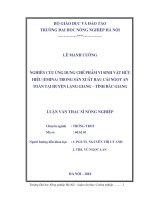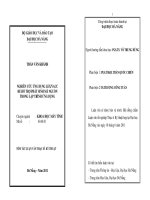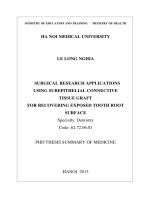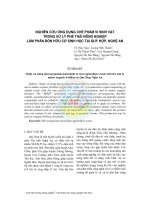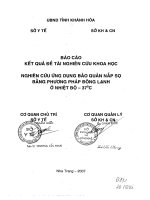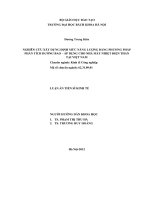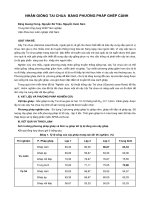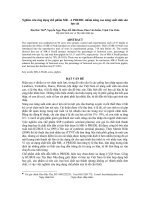nghiên cứu ứng dụng che chân răng hở bằng phương pháp ghép tổ chức liên kết dưới biểu mô bản tóm tắt tiếng anh
Bạn đang xem bản rút gọn của tài liệu. Xem và tải ngay bản đầy đủ của tài liệu tại đây (343.89 KB, 26 trang )
MINISTRY OF EDUCATION AND TRAINING MINISTRY OF HEALTH
HA NOI MEDICAL UNIVERSITY
LE LONG NGHIA
SURGICAL RESEARCH APPLICATIONS
USING SUBEPITHELIAL CONNECTIVE
TISSUE GRAFT
FOR RECOVERING EXPOSED TOOTH ROOT
SURFACE
Specialty: Dentistry
Code: 62.72.06.01
PHD THESIS SUMMARY OF MEDICINE
HANOI 2013
The work was completed in
HA NOI MEDICAL UNIVERSITY
The scientific guides:
1. Prof.PhD. Mai Đinh Hưng
2. PhD. Nguyen Manh Ha
Reviewer 1: Prof.PhD. Đỗ Quang Trung
Reviewer 2: Prof.PhD. Đỗ Duy Tính
Reviewer 3: Prof.PhD. Trương Uyên Thái
The thesis will be defended at the University level Council at
Hanoi Medical University
At time: hour, day month year 2013
The thesis can be found at:
1. National Library of Vietnam
2. Library of Hanoi Medical University
INTRODUCTION
The apical migration of the gingival margin is called gingival recession.
Gingival recession may occur on proper or misaligned teeth, crown or bridge
teeth, dental implant teeth. Gingival recession may lead to many problems
and functional aesthetics.
The percentage of gingival recession is relatively high in the World and
Vietnam. Surgery treatment for gingival receded tooth patients has not been
done much in Vietnam’s hospitals and dental offices.
For that reasons, we performed the study named “ Surgical research
application using subepithelial connective tissue graft for recovering
exposed tooth root surface”. This method combines the advantages of the
pedicle flap methods and the autogenous free gingival graft.
The goals of the study are:
1. Comment the clinical features of the gum receding cases
2. Evaluate the results of surgery about its safety, recovering the denuded
roots and changes of the gingival index.
URGENCY OF THE THESIS:
The gingival recession is common in people, however the treatment is
little done at Vietnam Hospitals and Dental offices. The research on the
treatment of Vietnam was less done. Our research focuses on the connective
tissue grafting, this method is more internationally recognized as highly
effective for covering the tooth root surface.
PRACTICAL IMPLICATIONS AND CONTRIBUTIONS OF THE
THESIS:
The results of the treatment showed that more than 71% of the tooth root
surface was recovered. This surgery is safe and effective at covering the
1
rooth surface. The aesthetic and functional results were maintained stabiy in
the follow-up time. This surgery is highly applicable and can be
implemented in all Dental offices and Hospitals.
THESIS STRUCTURE:
Introduction 2 pages, Overview 29 pages, Subjects and Methods 17
pages, Results 34 pages, Discussion 23 Pages, Conclusion 3 pages. There are
93 references.
Chapter 1: OVERVIEW
1. DEFINITION OF GINGIVAL RECESSION:
Gingival recession is a process in which the gingival margin receded to
the apex of the root (according to Glickman [15]).
2. CLASSIFICATION OF GINGIVAL RECESSION:
•
Miller’s classification [16]:
Class 1: The recession does not extend to the muco-gingival
junction and the periodontal tissue between teeth is not destroyed. Prognosis:
the whole denuded tooth root surface may be recovered by surgery.
Class 2: The recession extends to or beyond the muco-gingival
junction and the periodontal tissue between teeth is not destroyed. Prognosis:
the whole denuded tooth root surface may be recovered by surgery.
Class 3: The recession extends to or beyond the muco-gingival
junction and the interdental periodontal tissue is injured. Prognosis: the
denuded tooth root surface may be recovered partly by flap surgery.
Class 4: class 3 plus loosen teeth resulting from periodontitis.
Prognosis: Surgery treatment for covering denuded tooth root surface cannot
be successful. If these teeth are indicated to be conserved, do surgery for
augmenting attached gingiva.
2
Picture 1.10: Miller’s classification [16]
3. CAUSES AND FACILATING FACTORS OF GINGIVAL
RECESSION:
There are many causes of gingival recession such as physiological,
pathological, traumatic or a combination of these causes. Moawia M.Kassab
et al [17] aggregated some studies and concluded that there are many causes
leading gingival recession.
•
Pathological causes:
Periodontitis, deep periodontal pockets often lead to gingival recession.
•
Traumatic causes:
Incorrect tooth brushing technique at a long time makes gum worn.
Khocht A et al reported that there was a relation between hard tooth brushing
habit and gingival recession [18].
Occlusal trauma is a favorable factor that makes gingival recession
aggravate because it can lead to more epithelial proliferation and local
inflammation.
•
Physiological causes:
3
Physiological gingival recession increases with age, gingival recession
rate increase from 8% at child age to 100% at age of 50 (according to
Glickman [15]). After a study in Germany 1991 on 11401 people, Kleber-
BM concluded that 10,4% of persons had gingival recession at age of 16
to19; 24,8% of persons had gingival recession at age of 20 to 24; 46,8% of
persons had gingival recession at age of 35 to 44 [19].
•
Physiological and anatomical favorable factors:
The gingival recession is affected by the position of the teeth in the arch,
the angle of the tooth root in the jaw. For example: the canine erupts toward
the labial side, the outer bone layer is thin and the gingiva is thin too,
therefore it is easy for the gingival margin to recede.
4. CONSEQUENCES OF GINGIVAL RECESSION:
- The denuded tooth root surface is easy to be decayed.
- Tooth root cement surface is worn by hard brushing habit leading to
dentin hypersensitivity.
- It is easy for food debris, plaque and bacteria to adhere to tooth root
surface at interdental space.
- Compromise esthetic if gingiva recession occurs on front teeth.
5. STUDY ABOUT GINGIVAL RECESSION IN VIETNAM AND
ON THE WORLD:
Along with the development of cosmetic dentistry, gingival recession has
been more concerned.
In 2000, Arowojulu reported the gingival recession rate of a group of
Nigeria people: ages 16-25 : 22%; ages 56-65 : 58% [3].
In 2002, Hoanguan and colleagues reported the results of studies on the
gingival recession of adult groups in Thailand: : ages 51 - 59 : 49,6%, ages
4
70 - 92 : 72%, gingival recession had been more prevailed in men than
women [4].
In 2004, Sucin C et al examined 1460 people in the urban area of Brazil
and obtained results: More than half (51.6%) and 22.0% of the individuals
and 17.0% and 5.8% of teeth per individual showed gingival recession > or =
3 mm and > or = 5 mm, respectively [1].
In 2012, Minaya-Sanchez et al reported the gingival recession ratio in
pure Mexican men: The mean number of sites with gingival recession per
subject was 4.73; the prevalence was 87.6%.
In 1999, Long Le Nghia reported a research on 178 patients at National
Odonto-Stomatology hospital about gingival recession rate: ages 18-25:
72,16%; ages 35-44 : 98,77% [5].
6. GINGIVAL RECESSION TREATMENT:
Gingival recession is a periodontal tissue defect and should only be
treated by surgery. Surgical treatment has divided into three groups:
*Pedicle flap surgery:
-Laterally sliding flap.
-Oblique rotated flap.
-Double papilla sliding flap.
-Cervically repositioned flap.
- Semilunar flap.
*Autogenous mucosal tissue graft:
-Autogenous free gingival graft.
-Subepithelial connective tissue graft.
*Using membrane combined with pedicle flap:
- Acellular dermal matrix graft.
- Guided tissue regeneration.
5
7. RESEARCHES ABOUT SUBEPITHELIAL CONNECTIVE TISSUE
GRAFT:
In 2008, Ahathya RS et al did a study in India, at 6 months post surgery,
the result was 87.5% of denuded tooth root surface recovered [27]. In 2008,
Sergio L.S et al performed a clinical trial following-up of two Brazillian
groups: the non-smoking group had better result than the smoking group
[28]. Also in Brazil by the year 2006, Carvalho performed surgery and
followed-up 6 months, the effectiveness of recovering the exposed tooth root
surface was 96.7% [29]. Harris et al in U.S. in 2007 after 6 months of
postoperative follow-up showed the result that 95.4% of denuded root
surface was covered [30]. In 2002 he also performed the surgery on single
denuded roots and multiple denuded roots and found that the sing tooth root
surface was covered much more (90,3 % and 77%, respectively)[31]. In 2007
Dembowska E et al did a research in Poland and followed-up 12 months, the
result was 72.2% of exposed root surfaces recovered [34]. Rossberg M et al
studied a research on 39 teeth in Germany, he got the result of covering
89.7% of root surfaces after 6 years [32]. In Tehran, Sadat Mansouri S et al
in 2010 studied 18 teeth with receded gum grading I and II, 6 months later he
achieved 85.7% of exposed root surfaces recovered [33]. Cardaropoli 2011
tracked 12 months after surgery and showed the results 96% of toot root
coverage [34]. Nguyen Phu Thang's research in 2011 in Hanoi: 11 cases
transplanted autogenous connective tissue to cover the tooth root surface,
after 3 months there were 8 tooth roots were recovered partly [35].
Chapter 2: SUBJECTS AND METHODS
2.1. Subjects of study.
6
The study was performed on patients with tooth or group of teeth with
gum recession examined at the Hanoi University of Medicine and Dental
Center 225 Truong Chinh with the selection and exclusion criteria below.
2.1.1. Selection criteria:
Gingival recession grade I, II and III according to the classification of
Miller [16] and there is no acute or chronic periodontitis.
2.1.2. Exclusion criteria:
Exclusion of patients with 1 of the following criteria:
Having the acute systemic illness or unstable chronic diseases such as
diabetes, heart disease
Pregnant women at the first 3 months and the last 3 months.
Smoking patients.
Denuded teeth are loosen.
Donor region (palatal mucosa from the first premolar to the first molar)
has no sufficient thickness at least 2.5 mm (when the patient agrees to the
surgery, before the start of the incisions, anesthesia the soft tissue at
premolar palatal side and estimate the depth of the needle).
Other diseases, such as inflammation of the mouth, tumors, cysts that
interfere the surgery.
A history of allergy to anesthetics and antibiotics.
2.2. Time and place of study:
From March 2009 to December 2012. Study sites are Odonto-
Stomatology Department (before November 2009), Medical University
Hospital and Dental Center 225 Truong Chinh.
2.3. Research methodology:
2.3.1. Study design and sampling:
7
The uncontrolled open clinical intervention research to evaluate the
effectiveness of the before-after model. The patient had a tooth or group of
teeth had agreed to have had gingival surgery was included in the study by
convenient sampling, monitoring results, comparing before and after
treatment.
2.3.2. Sample size:
The research is on the patients, but the evaluation of the results of the
surgery is on the teeth (actually the patients had 2 or 3 gingival recession
teeth and the gingival recession grades were different and results of
recovering tooth surfaces on the same patient might vary), we calculate the
sample size by teeth.
The number of surgery teeth was calculated using the formula [61]:
{ }
( )
2
2
2/12/1
)1()1(
pp
pp
Z
pp
Z
oa
aaoo
N
−
−+−
=
−−
βα
We preferred α = 5%. Power samples 1-β = 80%.
po = 92% according to research by Yong-Moo Lee et al [62].
pa: re-covering ratio of the root surfaces estimated in this study
(approximately 80%).
N is equal to 43. In our study 49 gingival recession teeth were operated.
2.4. The research steps:
2.4.1. Gather information before surgery: according to study design
form.
1. Administrative information.
2. The reason to visit doctor.
3. Examine oral hygiene: based on OHI-S index (CI-S indices and DI-S
indices) of Green and Vermillion in 1964 [63].
2.4.2. Steps to conduct research and gather information in surgery:
8
* Prepare patients: Patients and family members (if patients were under 18)
were explained and signed a consensus to participate in research.
Blood counts and basic clotting tests were done.
* Preparation of drugs, devices and surgical materials.
* The surgical steps:
We carried out the surgical steps according to Langer B. and Langer L.’s. the
method [25]:
- Disinfect and anesthesia the surgical area.
- The recipient site (the gingival recession site) were incised by
two incisions: sulcular incision and papillary incision.
- Papillary incision: Make a 1 mm deep, horizontal and
perpendicular incision to the interdental papilla at the level of the cement-
enamel junction or slightly coronally to cement-enamel junction.
- Sulcular incision: this internal bevel incision is along with the
margin of gingiva and connects the papillary incisions on both sides. The
incision should be extended one more tooth on both sides for ease of flap
releasing.
- The blade 15 lip is used to lift the flap and small tissue pliers are
used to the reflected edge. A partial thickness flap is prepared apically while
the edge is pull slowly, with care taken to avoid penetrating the flap. A
partial thickness incision is extended sufficiently beyond bone edge for
access to the root surface and coronal displacement of the flap.
-After flap reflection, a recipient site is prepared, a curette is used for
root planning, granulation tissue and calculus are removed.
-Measure the height and width of the exposed root by placing the
periodontal probe on the root surface. Grind exposed root surface to reduce
the curvature of the root surface. If there is a cervical erosion, grind the root
surface to the bottom of the erosion. After grinding may be no cement left on
9
the root surface.
- Donor site: The soft palate mucosa from the distal of the canine to the
distal of the first molar. Antisepsis and anesthesia the mucosa at a distance
about 5-7 mm from the gingiva border. The first incision parallel to the
border of the gingival margin.
- Add 1 or 2 more incision that perpendicular to the first incision at the
both ends of the first incision. Connective tissue is dissected from the
mucosa with pouch opening style. The connective tissue layer and the
overlay mucosa are about 1.5 to 2 mm thick. If the mucosa is not thick
enough, peel off the bone membrane, piece of connective tissue is removed
and washed with saline and then soaked in physiological saline.
- The mucosa is sewn with polypropylene 5.0 or Vicryl 5.0.
The recipient site is prepared to receive the connective tissue:
- Removing granulation tissue, clean and smooth the root surface by
grinding the root surface with smooth burs. Root surface is exposed flat and
at horizontal plane to alveolar bone. Exposed root surfaces are highlighted
with saturated citric acid for 3 minutes then rinse with saline.
- Calculate the time of soaking the connective tissue in the saline
water.
-The connective tissue graft is placed on the receiving surface in any
direction, the edge of the connective tissue graft should leap over the margin
of the exposed root surface about 2 to 3 mm, at the cervical portion the
connective tissue graft should leap on the enamel margin. Sew connective
tissue graft that hung around tooth neck with prolene 6.0.
- Reposition the flap over the connective tissue graft and sew the flap
with interrupted and hanging suture. It is not needed to cover the graft
completely. During the healing process, the epithelial cell with lap over the
connective tissue, this is different from the method using the membrane.
10
- Pressed saline gauze to surgical areas for about 3 minutes to avoid
dead space between the flap and the connective tissue graft, the dead space
between the graft and the recipient surface. Put the periodontal cement on the
surgical wound.
*Gather information during surgery: the thickness of the palatal
mucosa corresponding to the teeth 4, 5, 6; the time of soaking the connective
tissue in the saline solution, enveloped flap or releasing incision flap.
*Guide to care for patients after surgery:
On the first day, to avoid the risk of bleeding in the mouth, the patient
should eat soft food, if the surgical site bleeds, take 1 moist tea bag and place
on the bleeding site and bite, then go to see a dental surgeon immediately.
To avoid possible gingival flap and connective tissue graft slipped, eat
soft food and don’t chew hard for the first week, do not brush teeth in the
surgical area during the first two weeks, just clean gently with a cotton swab
and betadine solution and saline via syringe, from the 3
rd
week, brush teeth
gently with a soft brush, brush from the gingiva to the teeth.
*Postoperative:
Patients have checked the next day, 1 week later, periodontal dressing
replaced at the 7th day, periodontal dressing taken off at the 12
th
day, suture
cut and removed at the 12
th
day.
Post-surgery drugs: Rodogyl (Spiramycine 750000UI combination
with Metronidazole 125mg) dose of 4 to 6 tablets / 7 days depending on
patient weight. Efferalgan 500mg * 3 times the first 2 days after
surgery. Alpha chymotrypsin 21μkatal edema, drink 2 tablets * 3 times per
day the first week.
2.4.3. Collecting information after surgery:
- Is there any symptoms of bleeding and infection at the first week
after surgery?
11
- Evaluate the results at the first week, 3, 6 and 12 months post-
surgery.
* After the first week:
At the recipient site: after removal of periodontal dressing, observe the
color of the soft tissue. If it is red, it is not covered by the epithelial layer. If
there is spotted white color, it is epithelial cells. If the soft tissue is necrosis,
it will turn pale. Don’t assess the inflammation at this time because in the
healing phase there is inflammatory response. If there is pus, it is considered
less effective. Evaluation Criteria at the first week are shown in Table 2. 1:
Criteria Highly
effective
group
Fairly
effective
group
Badly effective group
% of re-covering
the longitudinal
root surface
≥ 80% <80%
≤60%
≥ 80% <80%
≤60%
<60%
Abcess No No Yes or no
The first and 3
rd
months: Table 2.2: evaluate the surgical effectiveness of
re-covering the root surface:
Criteria Highly
effective
group
Fairly
effective
group
Badly effective group
% of re-covering
the longitudinal
root surface
≥ 80% <80%-
-≤60%
≥ 80% <80%
≤60%
<60%
Symtoms of
gingivitis
No No Yes or no
- Evaluation of recipient site: gingival condition: Is there any
inflamatory symptoms or not? The width of keratinized gingiva. The
horizontal and vertical size of gingival recession. Ratio of vertical root
surface re-covering.
12
- At palate: Is there soft tissue depressions or not?
The 6
th
and 12
th
months: Table 2.3: evaluate the surgical effectiveness of
re-covering the root surface:
Criteria Highly
effective
group
Fairly
effective
group
Badly effective group
% of re-
covering the
longitudinal
root surface
≥ 80% <80%-
-≤60%
≥ 80% <80%
≤60%
<60%
Symtoms
of gingivitis
No No Yes or no
Probing depth ≤ 3 mm ≤ 3 mm > 3mm
In addition to criteria at the time of 3
rd
month, there are some more
criteria: the size of attached gingiva in mm. Probing depth. Loss of
attachment.
2.5. Data processing:
The data collected in the study were entered into computer using
Microsoft access software and processed with the software Stata 10.0 with
the algorithm-square test, student's t-algorithm.
2.6. Ethics in research:
- Research council has adopted proposals and allowed to implement.
- Conduct research to ensure medical ethics.
Chapter 3: RESULTS
3.1. GENERAL CHARACTERISTICS OF RESEARCH SUBJECTS :
Table 3.3: Characteristics of surgeries.
Characteristics
of the
Number of teeth
each surgery
Number of
surgeries
Total
number
13
operations
1
toot
h
2
adja
-
-cent
teeth
3
adja
-
-cent
teeth
1
tim
e
2
time
s
3
time
s
Number of
the surgeries
5
25
16
4
Number of
teeth
5 32 12 49
Number of
patients
20 22
1
1
Comments:
- The 2 adjacent teeth per surgery accounted for the highest number
(16/25), 5 surgeries with one tooth and 4 surgeries with three adjacent teeth
together.
- There is one patient had two surgeries separated by six months. One
patient had 3 surgeries, the time interval between surgeries are twelve
months and six months, respectively. Two these patients are female. The
remaining of patients had 1 surgery.
3.2. SAFETY LEVEL
Table 3.12: Status of bleeding and infection of the surgery.
Time n Bleeding Number of
infection case
Recipient site
Palate
The first
day
25 0 0 0
The first
week
25 0 0 0
Comment: Based on the table above, this is a safe operation, without any
surgery complications of bleeding and infection.
3.3. RESULTS:
14
Chart 3.1: Effectiveness of the surgery at 1
ST
week post-surgery.
Comment: With the two criteria: the percentage of vertical re-covering the
tooth root and there was abscess or not, at the 1
st
week post-surgery the rate
of high effectiveness was 64% (that were the case of recovering the root
surface 80 % or more and there were no abscesses).
Chart 3.2: Effectiveness of the surgery at 3
rd
month post-surgery.
Comment: The ratio of high effectiveness at 3
rd
month post-surgery was
73%, increased comparing to 1
st
week, but this increase was not statistically
significant (p> 0.05).
Chart 3.3: Effectiveness of the surgery at 6
th
month post-surgery.
15
Comment: At the time of 6
th
month post-surgery, the rate of high-efficiency
group was 76%, higher than that at 3
rd
months but not significantly (p> 0.05).
Chart 3.4: Effectiveness of the surgery at 12
th
month post-surgery.
Comment: At 12
th
months post-surgery, the rates of high, fair and bad
efficiency were almost the same as those at 6
th
post surgery (p> 0.05).
Root coverage results after surgery:
Chart 3.5: Results of vertical recovering the root surface (in mm) at the time
of following-up after surgery.
Comment: the average of recovering the root surface at visit times after
surgery were more than 2.5 mm, the change from the pre-surgery to post-
16
Green: average
values.
Red: standard
deviation.
surgery was statistically significant (p values <0.01). Results achieved at the
time of 1
st
, 3
rd
, 6
th
, 12
th
months were not differently significant (p> 0.05).
The rate of recovering 100% of the root surface at the times after
surgery.
Table 3.16: Percentage of recovering 100% of the root surface at the times
after surgery.
Times
Parameters
3
rd
month 6
th
month 12
th
month
Recovering
100% of the
root surface
33/45=73,3% 34/46=73,9% 25/35=71,4%
Recovering
under 100% of
the root surface
12/45=26,7% 12/46=26,1% 10/35=28,6%
P (compared to
3
rd
month post-
surgery)
>0,05 >0,05
Comments: The rate of recovering the root surface entirely at 3
rd
, 6
th
, 12
th
months post-surgery were no different with p> 0.05. In general, over 71% of
tooth rooth surfaces were fully covered.
The probing depth before and after surgery.
Table 3:20: Comparison of probing depth before and after the operation:
Times
Parameters
Before
surgery
6
th
month
post
surgery
12
th
month
post
surgery
18
th
month
post
surgery
24
th
month
post
surgery
Nmber of teeth (n)
49 46 35 11 8
Probing depth(mm)
1,2± 0,5 1,0± 0,4 1,0± 0,4 0,9± 0,2 0,9± 0,2
p (compared to pre-
surgery) <0,01 <0,01 <0,01 <0,01
p (compared to 6
th
post surgery) >0,05 >0,05 >0,05
17
Comment: probing depth at 6
th
, 12
th
, 18
th
and 24
th
months post-surgery
reduced with no statistical significance compared with the pre-operative
score (p values <0.01). At the time of 12
th
, 18
th
and 24
th
months after surgery
the probing depth changed without statistical significance compared to the 6
th
months post-surgery (p values> 0.05).
Keratinized gingiva at the time before and after surgery:
Table 3:21: The change of keratinized gingiva at the post-surgery visits:
Comment: The width of keratinized gingiva at 1
st
, 3
rd
, 6
th
, 12
th
and 18
th
months had increased significantly compared with the pre-operative score (p
values <0.01). The width of keratinized gingiva between 6
th
, 12
th
and 18
th
months visits did not change significantly compared to 3
rd
month (p values>
0.05).
Chapter 4: DISCUSSION
4.1. DISCUSS THE GENERAL CHARACTERISTICS OF RESEARCH
SUBJECTS:
Features of surgeries:
Based on table 3.3: the proportion of the surgeries with 2 adjacent teeth
was major. Most patients participated 1 times, although many of these
18
Times
Parameters
Before
surgery
3
rd
month
PS
6
th
month
PS
12
th
month
PS
18
th
month
PS
24
th
month
PS
Nmber of teeth
(n)
49 45 46 35 11 8
Width of
attached gingiva
(mm) 2,4± 1,8
4,2±
1,5
4,2±
1,5
4,1±
1,6
5,4±
1,4
5,0±
0,9
p (compared to
pre-surgery) <0,01 <0,01 <0,01 <0,01 <0,01
p (compared to 3
rd
post-surgery) >0,05 >0,05 >0,05 >0,05
patients still had gingival recession teeth after the first surgery. There were 1
patient having had 2 surgeries and 1 patient having had 3 surgeries, both
patients were female. Obstacles of having further surgery for most patients
were the discomfort in the mouth in the first week after surgery.
4.2. DISCUSSION OF RESULTS OF SURGERY:
The effect of surgeries:
The surgeries were considered effective when the denuded root surfaces
were recovered and the graft stuck to the root surfaces. The color of the soft
tissue and hypersensitivity were not considered the criteria for success of the
surgeries because this surgery was a harmonious colored surgery and it was
difficult to find the sensitive spot on the cervix or on the root.
Based on chart 3. 1: The ratio of high efficiency levels at the 1st month
was 64%, at that time we had only two criteria: the percentage of recovering
the vertical tooth root equal to 80% or more and no abscess, we did not rely
on probing depth because according to some authors during the 1
st
month
after surgery the graft did not stick to the tooth root surface [52]. During the
first 4 weeks patients were instructed not to brush the surgery area and
cleaned with saline spray, that were the reasons why there was slight
gingivitis because not all plaque was thoroughly removed.
As chart 3.2, at the 3rd month the success rate of high efficiency was
73%, comparing with the first week after surgery the rate increased because
a number of teeth at the 1
st
week had recovered 80% or more of root surface
but there were gum disease symptoms, at 3
rd
month the teeth were good
plaque controlled so gingivitis reduced and increased the high efficiency
ratio, but the difference between these scores were not statistically
significant.
19
At the time of 6
th
month after surgery, the success rate of high efficiency
was 76%, from that time onwards the probing depth of 3 mm or less was
added to the criteria for evaluating surgical effectiveness, grafts were
attached to root surface or not were assessed by probing depth, if the gingiva
did not adhere to the foot surface, it would make a gingival pocket.
At 1 year after surgery (chart 3.4), the success rate of high efficiency
was 74%, the results in both 6
th
and 12
th
month visits had confirmed that the
connective tissue graft covering the tooth root were in harmony with the soft
tissue around and stuck to the surface of the tooth root at the cement and
tooth dentin portions (in most cases we ground the root surface to reduce the
curvature of the root surface and exposed dentin). The graft could attach to
the cervical erosion also.
The rate of re-covering 100% root surface:
This ratio is also a criterion for evaluating the effectiveness of surgical
procedures. At examination of times after surgery (Table 3.16), the rate of
fully covering of root surface were generally 71% or more in the
postoperative following-up times of 3
rd
, 6
th
, 12
th
month and did not differ
significantly between the times. This is the first study we did connective
tissue grafts covering the tooth root, most of the cases covering 100% of root
surfaces were at the second half-time of the study so we believe that this is a
highly effective surgery with experience surgeon. A number of foreign
researchers reported that the rate of recovering the root surface completely
were quite high, for example, RJ Harris. [77] in 2003 treated 50 teeth, 29
tooth roots (58%) were recovered 100%.
The change of keratinized gingiva after surgery:
The keratinized gingiva width counts from gingival margin to muco-
gingival junction, gingival recession reduced the size of keratinized gingiva,
even no gingiva left, in this case the mucosa edge was pulled during chewing
20
enabling bacteria getting into the sulcus leading to symptoms of
inflammation. Connective tissue grafts are highly effective in restoring
keratinized gingiva. According to table 3.21: In our study, at the 12
th
month
visit: the average of keratinized gingiva width was 4.1 mm compared with
2.4 mm before surgery, this difference was statistically significant with p
<0.01. Compared to the findings of other authors: Alkan EA [80] in 2011
reported the result after 1 year following-up of 16 transplants in Ankara, the
average of keratinized gingiva width increased 2.4 mm; Cairo F [70] and his
colleagues in 2008 informed the results of a study of connective tissue graft,
the average of keratinized gingiva width increased 1.3 mm; Hiral [87] et al:
the average of keratinized gingiva width increased from 2.5 mm to 3.3 mm at
6
th
month follow-up. Pierpaolo Cortellini [88] and his colleagues in 2012
reported the results after one year: keratinized gingiva width increased 3 mm
on average, which the author emphasized that he did not move the flap
toward the cervix when sewed graft and flap. Other studies have also
concluded that the keratinized gingiva width increased after surgery [80],
[68], [89], [90], [82].
The change of probing depth after surgery:
Probing depth and the size of keratinized gingiva are important
indicators to evaluate the adhesion of the graft and flap on the surface of the
tooth root, which evaluate the effectiveness of the connective tissue graft
method recovering the tooth root surface. If the connective tissue graft was
not stuck to the tooth root surface, the surgery can not be considered
successful, this will increase the probing depth (inducing gingival pocket). In
this study the probing depth was measured at the mid-point of the labial
gingival margin.
21
Based on table 3.21: the average probing depth decreased significantly
at 6
th
month visit (1mm) compared with preoperative (1.2 mm) (p <0.01).
The probing depth at post surgery visits did not change significantly. Some
authors reported research results: probing depth was significantly reduced
after surgery as Ahathya RS [27], Arthur B [92], Aroca S [68], Elizabeth
[89], Hiral M [84]. Some authors reported probing depth did not change or
changed not significantly after surgery as Cairo F 2008 [70], Christine
Romagna [76], Haim Tal [74], Michele Paolantonio [64].
According to our experience, there are many factors affecting the
probing depth after surgery: tooth root surface is cleaned of bacteria and
exogenous factors or not, root surfaces conditioned or not, gum in the
healing process is injured by trauma or solid food or toothbrush that detaches
the gingiva from tooth surface or not. Chronic gingivitis occurs after surgery
makes probing depth increase.
CONCLUSION
1. CLINICAL FEATURES OF GINGIVAL RECESSION CASES:
-The average age of patients was 34.9.
-Women involved more in surgery than men, the rate is nearly twice that of
men.
-Rate of good oral hygiene at 12
th
post-surgery was significant higher than
that at pre-surgery (p> 0,05).
-The rate of upper teeth operated was higher than that of lower teeth in both
sexes (p> 0,05). Premolar teeth proportion war the highest.
2. SURGERY OUTCOMES:
- Connective tissue grafts recovering the exposed tooth root surface was a
safe surgery.
22
- Connective tissue grafts recovering the exposed tooth root surgery was
highly effective, at 1 year after surgery, the rate of high effectiveness was
74%, the rate of fair effectiveness was 14% and the rate of bad effectiveness
was 12%.
- The average of recovering the vertically tooth root surface in the first year
ranged from 2.6 ± 1.4 mm to 2.7 ± 1.4 mm equivalent to an average of
84.6% to 86.9%. Postoperative results differed significantly from that at pre-
surgery (p <0.01), no statistical difference at the time of 1
st
, 3
rd
, 6
th
and 12
th
visits.
- More than 71% of the tooth root surfaces were completely recovered in the
examinations of post-surgery.
- Gingival recession height reduced significantly after surgery (p <0.01.
Between the postoperative visits the gingival recession height differences
were not statistically significant (p> 0.05).
- Gingival recession width reduced significantly after surgery (p <0.01;
between the post-surgery visits the gingival recession width differences were
not statistically significant (p> 0.05).
- Attached gingiva width increased significantly after; between postoperative
visits the index of attached gingiva changed without statistical significance.
- Probing depth changed significantly from pre-surgery to post-surgery. The
probing depths of 6
th
and 12
th
post-surgery changed without significant
difference.
- Keratinized gingival width increased significantly after. Between the visits
the keratinized gingiva width changed without statistical difference.
23
